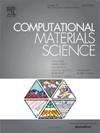Orientation selection in alloy dendritic evolution during melt-pool solidification
IF 3.1
3区 材料科学
Q2 MATERIALS SCIENCE, MULTIDISCIPLINARY
引用次数: 0
Abstract
Investigations of directionally solidifying melt pools during metal additive manufacturing (AM) reveal that the resulting subgrain cellular structures often grow along crystalline orientations different from the temperature gradient direction, some of which are not even along preferred crystallographic directions. It is well-known that dendrite orientation results from the growth competition between the heat flow direction and preferred crystallographic orientation. Specifically, the competition between interfacial anisotropy and process anisotropy (thermal gradient and interface velocity) during directional solidification leads to rich morphological diversity of the resulting dendritic structures, including tilted dendrites and seaweed patterns. The orientation selection mechanisms of such patterns remain unexplored at high velocity in the frame of AM. This study examines the tilted growth of cellular-dendritic arrays as a function of the misorientation angle () between the thermal gradient and crystal lattice directions and other relevant control parameters. We use a phase-field model to explore dendritic evolution in a binary alloy during high-velocity solidification in two-dimensions. We find marked effects of thermal gradient, growth velocity, alloy composition, and anisotropy parameters on the possible growth directions and the primary arm spacing, constitutional undercooling, microsegregation, and secondary phases that arise during dendritic solidification. Our work provides a detailed yet concise presentation on the tilted growth and morphological transition for a broad range of thermal conditions in the high-velocity regime and the full range of for establishing orientation selection maps. These results reasonably agree with experimental measurements and should have qualitative relevance for controlling the subgrain structure, chemical segregation, and texture randomization in a wide range of commercial dendrite materials relevant to AM.

求助全文
约1分钟内获得全文
求助全文
来源期刊

Computational Materials Science
工程技术-材料科学:综合
CiteScore
6.50
自引率
6.10%
发文量
665
审稿时长
26 days
期刊介绍:
The goal of Computational Materials Science is to report on results that provide new or unique insights into, or significantly expand our understanding of, the properties of materials or phenomena associated with their design, synthesis, processing, characterization, and utilization. To be relevant to the journal, the results should be applied or applicable to specific material systems that are discussed within the submission.
 求助内容:
求助内容: 应助结果提醒方式:
应助结果提醒方式:


